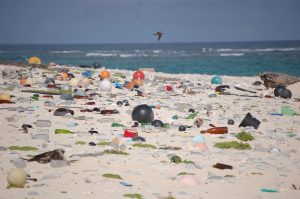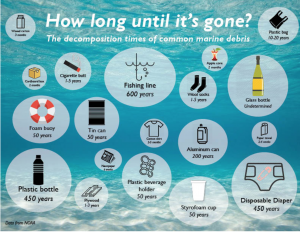Plastic pollution is one of the major issues effecting the marine environment today.
A study published on February 13 2015 by Science investigated the input of plastic into the oceans from land. Using worldwide data, the study estimated that 192 coastal countries generated 275 million metric tons (MT) of plastic waste in 2010 alone, with 4.8-12.7 million MT of that waste entering the ocean.

Marine debris that was washed ashore covers a beach on Laysan Island in the Hawaiian Islands National Wildlife Refuge. (Susan White/USFWS)
What is bioplastic?
Bioplastics are plastics that are partially made of biological materials like wheat, maize, and tapioca. Being made of biological material does not mean that bioplastics can be broken down by fungi and bacteria. Essentially, being bioplastic does not necessarily mean that the material is truly biodegradable.
Examples of non-biodegradable bioplastics include bio-based Polyethylene terephthalate and Polyethylene which make up everyday items such as bottles and carry bags.
There are bioplastics that can degrade in the environment, given specific conditions. For example, Kale et al. published a study in 2007 that investigated the biodegradation of polylactide bottles. The study found these bottles degrade after 30 days when buried in soil, at relatively high temperatures.
What is biodegradable plastic?
The definition of biodegradable is the break down of substances into inorganic materials, such as water and oxygen.
“This word ‘biodegradable’ has become very attractive to people trying to make quick bucks on it,” explains Ramani Narayan, a professor of Chemical and Biochemical Engineering at Michigan State University, who helped develop biodegradable corn-based plastic.
Typically, companies make plastics that degrade into smaller particles faster and then claim that they are ‘biodegradable’ says Narayan. Figure 2 shows the relative rates of degradation of various materials. Even though they are claimed to be biodegradable, they still take large amounts of time to degrade into smaller particles – which are no better for the environment.

Figure 2: Image depicting the relative rates of degradation for various materials. Obtained from creative commons.
Why does this matter?
The general public does not know the difference between bioplastics and biodegradable plastics. They also do not know that companies use the term ‘biodegradable’ lightly – and just because plastics claim to be biodegradable does not mean they actually are. This would cause people to assume that using and disposing of bio- and biodegradable plastics is safe for the environment, when that is not the case.
This discarded plastic would eventually find its way into the ocean, further increasing the plastic pollution in the marine environment. Plastic debris in the ocean is known to increase the rate of ingestion, suffocation and entanglement of hundreds of marine species – often resulting in death.
It is important to know the distinction between bio- and biodegradable when using plastics, such that they can be disposed/recycled in the appropriate manner.
The easiest solution would be to minimize your plastic use entirely, to reduce the rate of plastics entering the ocean and reduce the endangering of wildlife.
-Chantell Jansz
